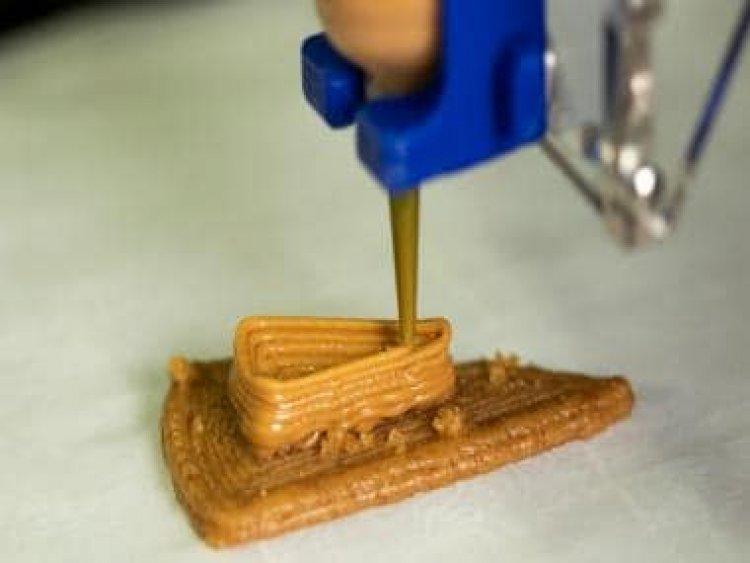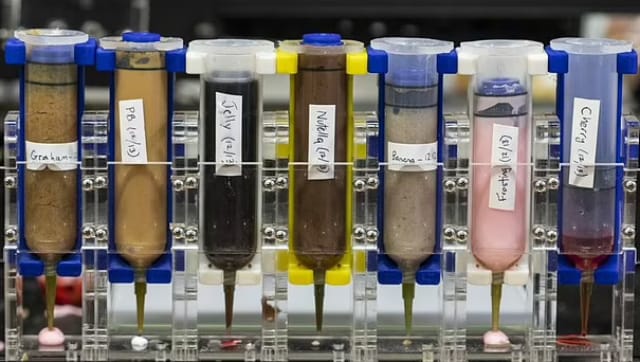CTRL+P for food: Scientists create world's first 3D-printed cheesecake in just 30 minutes
CTRL+P for food: Scientists create world's first 3D-printed cheesecake in just 30 minutes

In a development that could ideally mean the end of food scarcity, and perhaps also put an end to spending long hours toiling in the kitchen for good food, a team of researchers have successfully 3D printed a cheesecake that too in under 30 minutes.
A team of engineers and food tech researchers at Columbia University, New York, revealed the world’s first 3D printed food, a piece of cheesecake, created by carefully stacking seven edible inks to make a triangular shape.
How a cake was 3D printed?
The base is of the cake is made using graham crackers, with layers of peanut butter, Nutella, cherry drizzle, banana purée, strawberry jam, and whipped cream all stacked one on top of the other in a careful manner. The ingredients are stored in individual containers, in an “ink tank.”

“Because 3D food printing is still a fledgling technology, it requires an ecology of supporting sectors such as food cartridge makers, digital recipe files, and an atmosphere in which to develop and share these recipes,” said lead author Jonathan Blutinger in a statement.
“Its customizability makes it especially useful for the plant-based meat market, where texture and flavour must be meticulously made to imitate real foods,” says the company.
The crew modified an off-the-shelf 3D printer to use the ingredients as ink, and the laser toasted the graham cracker paste for a more crusty structure.
The printer’s head has a tiny syringe tip that captures the precise components set into its software.

Engineers created the confection on a computer, pressed a switch, and the machine began construction on the seven-layered cake.
The aim of 3D printing food
The team has not revealed how the cheesecake tastes, only that it is vegan, but the project is meant to show how 3D printing will revolutionise the food assembly business.
According to the lead engineers, precision printing of multi-layered food products could result in more customizable foods, improved food safety, and the ability for users to regulate the nutrient content of meals more readily – and in less time. This would also lead to a major reduction in food wastage at the professional level, thereby helping food security as well.
“The cheesecake contained a record-breaking amount of components in a single printed food product,” according to the experts’ report published in Nature.
“The form of our print became comparable to building a house, where the base (graham cracker) and interior pools (Nutella and peanut butter) held softer components within (banana and jelly),” said the engineers.
The system produced the ultimate cheesecake after seven tries by the crew.
We have a huge issue with the poor nutritional content of processed meals,” said Christen Cooper of Pace University Nutrition and Dietetics.
Processes food, but with its own benefits
3D food manufacturing will still produce processed foods, but perhaps the silver lining will be greater control and customization of nutrition, personalized nutrition, for some individuals.
It may also be helpful in making food more attractive to those with swallowing problems by imitating the forms of real foods with the pureed texture foods that these patients require.
The team thinks that the technique will assist cooks in localising flavours and textures on a fine scale in order to create new culinary experiences.
“People with nutritional limitations, parents of small children, nursing home dieticians, and athletes, among others, could find these personalised methods very helpful and handy in meal preparation,” the engineers explained.
Cooking may become more cost-effective and sustainable as a result of the system’s use of high-energy focused light for high-resolution customised heating.
“The research also emphasises that printed food plates will likely require innovative component compositions and structures, due to the distinct way the food is ‘assembled,'” said Hod Lipson, who has been working on the technology at Creative Machine Labs since 2005.
“A lot of work remains to be done in order to gather data, analyze, and optimise these processes,” they added.
Read all the Latest News, Trending News, Cricket News, Bollywood News,
India News and Entertainment News here. Follow us on Facebook, Twitter and Instagram.
What's Your Reaction?



























































